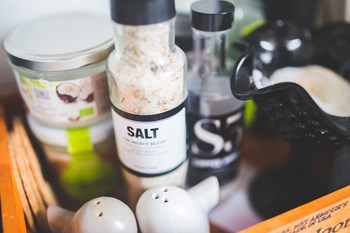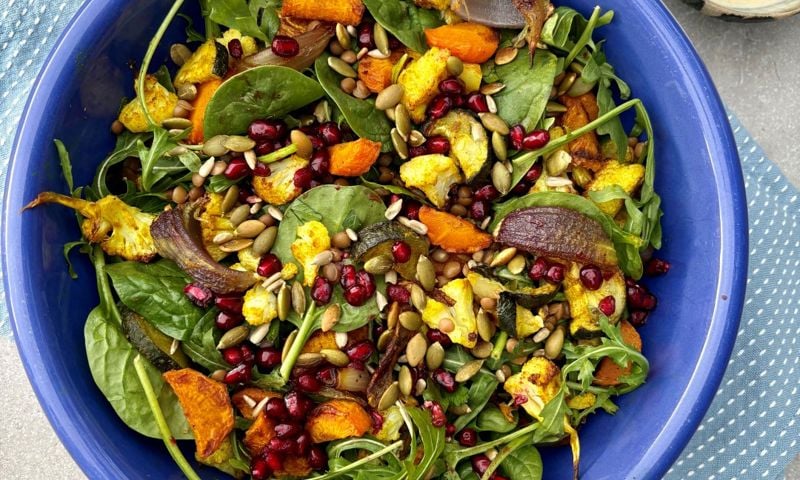Can’t go without that extra sprinkle of salt on your breakfast, lunch or dinner? Salt may be delicious and essential for life, but too much can trigger health issues that aren’t so delicious.
The lowdown on salt
Salt is a mineral that consists of sodium and chloride; the sodium element is what’s problematic when consumed in large doses. Australians are notorious for their salt intake: Better Health Channel found that the average Aussie consumes about three times more sodium than what’s required for good health.
 Our bodies need a healthy amount of salt to survive: the essential minerals in salt help to balance the body’s fluid, nerve transmissions and muscle function. Our kidneys are responsible for regulating sodium levels in the body. Having too much and too little sodium can cause many high-risk health conditions. If sodium levels experience a massive drop in the body, a hormone called aldosterone is released which holds sodium in the body by reducing the amount lost in urine, which can prove dangerous over time.
Our bodies need a healthy amount of salt to survive: the essential minerals in salt help to balance the body’s fluid, nerve transmissions and muscle function. Our kidneys are responsible for regulating sodium levels in the body. Having too much and too little sodium can cause many high-risk health conditions. If sodium levels experience a massive drop in the body, a hormone called aldosterone is released which holds sodium in the body by reducing the amount lost in urine, which can prove dangerous over time.
How much is too much?
The Heart Foundation found that most of us are consuming around 10 grams a day, when adults should really try to consume no more than 4-6 grams of salt per day to help avoid chronic disease (about 1 teaspoon). Those with high blood pressure are especially advised to reduce their salt intake to no more than 4 grams per day. Salt intake above the recommended 4-6 grams is associated with high blood pressure; subsequently increasing the risk of kidney disease and cardiovascular diseases like heart disease and stroke. If in doubt the sodium and salt converter is a great tool that converts the sodium listed on food products into grams of salt or vice versa.
Salt and your body
Associated conditions that may occur from sodium overconsumption may include:
- Heart failure/heart attack
- High blood pressure
- Kidney problems and kidney stones
- Stroke
- Stomach cancer
- Left ventricular hypertrophy (thickening of heart muscle)
- Osteoporosis
- Oedema (fluid retention)
However, cutting salt completely out of your diet can be harmful. A low-salt diet may have reverse health effects according to Healthline, such as elevated LDL cholesterol levels, heart failure and insulin resistance. Consult your doctor if you believe you are at risk of any negative health effects from low salt consumption.
Cutting back on salt
Think you might have an addiction to salt? Well it just takes a bit of cutting back to train your tastebuds to adjust to a less salty lifestyle. On average, 25 per cent of our salt intake is in cooking or at the table, with the other 75% coming from packaged and processed foods. These are things like bread, breakfast cereals, chips, cheese, processed meats and condiments. Salt is added as a preservative in the flavouring process of food manufacturing, so it’s hard to avoid it entirely. However, by simply phasing our salt in unnecessary places, you will be surprised at how quickly you develop a less salty palette.
Fresh is better
 You’ve heard it all before folks, but the simplest way to cut salt from your diet is to add more fresh food onto your plate. Fruit, veggies, whole grains, fish, poultry, nuts and seeds are all naturally low in salt. By slowly substituting your processed foods with fresh items, you’ll be on your way.
You’ve heard it all before folks, but the simplest way to cut salt from your diet is to add more fresh food onto your plate. Fruit, veggies, whole grains, fish, poultry, nuts and seeds are all naturally low in salt. By slowly substituting your processed foods with fresh items, you’ll be on your way.
This could mean snacking on celery or carrot sticks instead of chips and crackers, or opting for low-fat yoghurt or unsalted nuts when you hit that afternoon slump. Home-made popcorn with no added salt or butter is also a great option if you’re really craving a bite-sized snack.
Substitute
You can also actively limit your salt intake by reducing the salt you add while cooking and sprinkling onto finished meals. Try fresh alternatives like dried herbs and spices, lemon juice, garlic, and black pepper to spice up your dish instead.
If you’ve got a keen eye for the Nutrition Information Panel on packaged foods, you could try switching to a brand with less sodium i.e. those labelled with ‘no added salt’ or ‘salt reduced’. According to the Heart Foundation, food with less than 120mg sodium per 100g is considered low in salt, and packaged food with less than 400mg per 100g is ideal.
Recipe
Not quite sure where to start? Why not start from the very beginning – breakfast! This delicious baked eggs and beans recipe is a great way to re-adjust your taste buds without having to sacrifice flavour – just opt for the low sodium baked beans option at the supermarket. The best part is, this meal can be repurposed for lunch and dinner – total winner.
Ingredients
- 1 x can of baked beans, rinsed and drained (look for low sodium tag or compare nutrition labels)
- 1 x 150g bag of fresh spinach
- 2 x eggs
- 3 x tomatoes, roughly chopped
- ½ tsp chilli flakes
- 1 tbsp fresh coriander, chopped
- Olive oil
Method
1. Heat oven to 200C
2. Mix baked beans, tomatoes, chilli flakes and chopped coriander into an ovenproof dish. Depending on preference, either add spinach fresh or wilt the spinach in a colander with boiling water and drain before combining
3. Make a small well in the dish and crack both eggs into the centre of the ingredients
4. Bake for 12-15 minutes, or until eggs are cooked as desired
5. Remove from oven, garnish with left over coriander and serve



